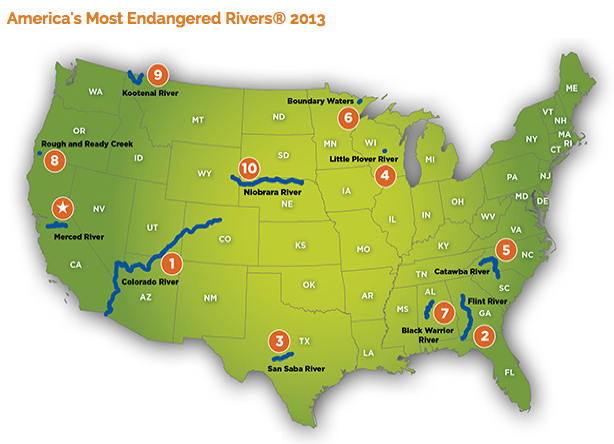Coal, poor water management endanger Southern rivers

A national water protection advocacy group has released its annual list of the 10 most endangered U.S. rivers, and it includes four in the South at risk from coal and poor water management.
Coming in as the second-most endangered on American Rivers' list, following the drought-stricken Colorado, is the Flint River in Georgia, which is imperiled by outdated management. The Flint provides water for over 1 million people and 10,000 farms, but it's going dry to excessive agricultural withdrawals and increasing municipal demands.
"Despite being in a historically wet are of the country," American Rivers says, "in recent years many Flint River tributaries dried up completely."
The group calls on the state of Georgia to take action to better protect the Flint, particularly during droughts.
The third-most endangered river is the San Saba in Texas, also at risk from excessive agricultural withdrawals.
"Through wasteful water use and unregulated pumping, irrigators are transforming a vibrant, pristine river into a dried up riverbed," according to American Rivers.
The Texas Commission on Environmental Quality should enforce existing laws to protect the San Saba, the group says, and the Texas legislature should appoint a watermaster on the river's upper stretch to better manage flows.
Coming in at fifth-most endangered, after the fourth-place Little Plover in Wisconsin, is the Catawba River, which runs through the Carolinas. The risk to the Catawba is toxic coal ash from Duke Energy's Riverbend power plant near Charlotte, N.C. The ash is stored in massive ponds that are leaking pollution into the waterway.
"North Carolina’s Department of Environment and Natural Resources must require Duke Energy’s Riverbend power plant to ensure the coal ash ponds are sufficiently maintained in perpetuity to safeguard the river and water supply for future generations," American Rivers says.
Also imperiled by coal is the Black Warrior in Alabama, rated the seventh-most endangered following Minnesota's Boundary Waters, which are at risk from copper and nickel mining. The threat to the Black Warrior is from the Shepherd Bend Mine, a 1,773-acre Drummond Co. coal operation that wants to discharge polluted wastewater into the river just 800 feet from a major drinking water intake. In order to do that, however, Drummond must obtain leases from property owners, including the University of Alabama.
"The University must stand up for the health of area residents, students, and drinking water customers by permanently refusing to sell or lease its land and mineral rights at Shepherd Bend for coal mining," American Rivers says.
Coming in eighth place are the Rough & Ready and Baldface Creeks in Oregon, imperiled by nickel mines, followed by the Kootenai River that runs through British Columbia, Montana and Idaho and is endangered by open-pit coal mines, and the Niobrara in Nebraska, South Dakota and Wyoming, which is at risk from sediment build-up and flooding.
Getting a special mention was California's Merced River, which is threatened by intentional flooding from a dam project.
American Rivers' report has helped bring about positive changes in past years. They include the removal of outdated dams, the protection of rivers with Wild and Scenic designations, and the prevention of harmful development and pollution.
Tags
Sue Sturgis
Sue is the former editorial director of Facing South and the Institute for Southern Studies.
